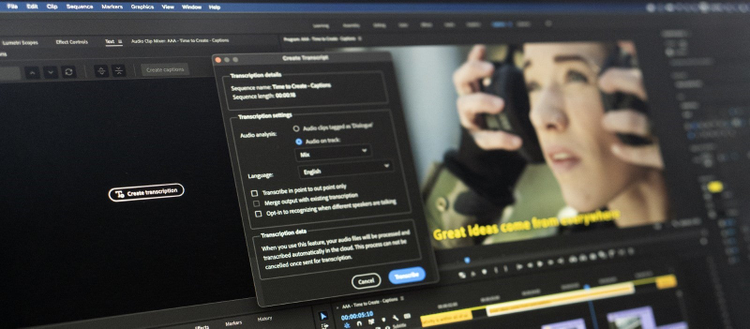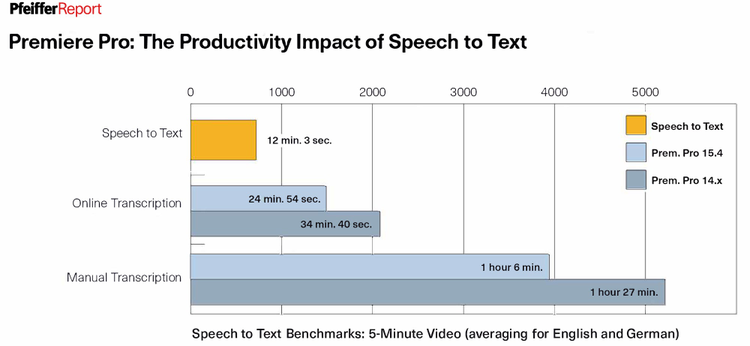Speech to Text and Native M1 performance on Mac now available in Premiere Pro

Speech to Text in Premiere Pro.
Content creators know that captions are critical for engaging viewers on social platforms because most videos are seen on mute. But until now the options for adding captions to videos have been too inaccurate, time-consuming, or expensive. Available now, Speech to Text in Premiere Pro gives creators all the tools they need to make captioned videos the new standard. With Speech to Text, Premiere Pro is the only non-linear editing system (NLE) offering an integrated and automated workflow for creating transcriptions and captions. Speech to Text is, on average, 5x faster than other captioning workflow and is included at no additional cost for subscribers.
There’s more in the July release to help creators work faster and deliver videos that stand out. Native support for Macs powered by M1 in Premiere Pro, Media Encoder, and Character Animator, accelerates those applications on the latest Macs. New text and graphic capabilities give storytellers more creative tools for titles and captions. Across the release, and in public Beta, there are improvements for collaboration, color, and performance. After Effects (Beta) introduces powerful new Multi-Frame Rendering features for faster motion graphics workflows and new capabilities in Character Animator (Beta) clear the way for more creators to get into animation.
Read the Pfeiffer Report on Speech to Text productivity gains.
Speech to Text in Premiere Pro
In the marketplace for attention, the value of captions is beyond dispute. Research shows that viewers watch captioned videos longer and recall content better, including ads. Videos with associated transcription files, such as SRT, rank higher in search results because they are more discoverable in search engines (SEO). Captions also make video more accessible: one in five people around the world live with some level of hearing loss. Modern creators know the importance of captioning their videos, but the process has been tedious and slow, requiring editors to either make their captions manually or switch between different services and applications for the various tasks.
Premiere Pro changes all of that, allowing users to complete each step of the captioning workflow inside their video editing application. Speech to Text can save hours, automating the time-consuming tasks while still giving the user full creative control over the results. According to a new Pfeiffer Report, using Speech to Text and the new Captions workflow in Premiere Pro slashes the time needed to create a transcription and captions for a 5-minute video by 75 percent, saving an editor 52 minutes. And there are other time-saving advantages, such as new ways to search and navigate video sequences: double-click on a word in the Text panel and the playhead moves to that position in the Premiere Pro timeline.
Speech to Text includes support for 13 languages, and early access users around the world have confirmed the impressive accuracy of their transcriptions. When changes are needed, such as correcting the spelling of names, users can easily edit the text in the transcript. When the transcript is ready, Speech to Text automatically creates captions on the Timeline, leveraging the power of Adobe Sensei machine learning to match the pacing of human speech. Once the words are on the Timeline, captions can be customized using the design tools in the Essential Graphics panel.
Speech to Text is included with Premiere Pro or Creative Cloud All Apps subscriptions at no additional cost, enabling Premiere Pro users to increase the value of their video content easily and efficiently.
Premiere Pro on M1-powered Macs
Premiere Pro and Adobe video apps enable editors and content creators to leverage the latest Mac hardware so they can keep up in a fast-paced world. With native support for M1 on Mac, Premiere Pro runs nearly 80 percent faster than comparable Intel-based Macs (see Premiere Pro on Apple M1: the results are in). As users upgrade to M1-powered Macs, Premiere Pro is ready for them. Along with Premiere Pro, the July release includes M1 support for Media Encoder and Character Animator. Premiere Rush and Audition received M1 support in April and May, respectively. And M1 support for After Effects will be introduced in public Beta later this year. After Effects integration features within Premiere Pro, such as Dynamic Link and Motion Graphics templates, have already been optimized for M1-powered Macs.
Learn more about what’s new in Premiere Pro 15.4 and Character Animator 4.4.
Multi-Frame Rendering in After Effects (Beta)
With Multi-Frame Rendering, the After Effects architecture is being modernized to take advantage of multi-core CPUs for up to 3x faster performance. The After Effects (Beta) has added Multi-Frame Rendering for Previews, providing faster on-screen rendering and an overall more responsive experience. In addition, with Speculative Preview, After Effects automatically detects when your system is not active and uses that time to render compositions. For more information on the latest Multi-Frame Rendering features, see the latest After Effects blog post.
Body Tracker and Puppet Maker in Character Animator (Beta)
More and more creators are discovering how animated content increases engagement and builds audiences — as shown by the growth of animation on platforms like Instagram, TikTok, and others. To take advantage of the trend, powerful new public Beta features make it easier to step into animation and make the workflow faster and more fun for everyone.
Body Tracker (in public Beta), powered by Adobe Sensei: For the first time, Character Animator Lets creators use their body movements and gestures to animate their puppets, even if they don’t have experience with animation or keyframing. Move for the camera and your puppet moves along with you.
Puppet Maker (in public Beta) enables fun, fast, diverse character creation for everyone — no need to be an expert Photoshop or Illustrator user, and no need for rigging skills. Choose from a variety of character styles. Then with the simple interface, start customizing the character by picking hairstyles, skin tones, accessories, and much more.
Now, with native support for M1-powered Macs, a real-time application just got faster, delivering workstation-caliber performance on the latest Macs. Puppet and artwork import is twice as fast and switching between workspaces in Character Animator is up to 3x faster than comparable previous generation Macs.
Explore new features in public Beta
Public Beta gives you the opportunity to test new features while they’re still in development — and share your feedback with the Adobe product teams. Major features now in public Beta include new Import and Export workflows in Premiere Pro (Beta), Multi-Frame Rendering features in After Effects (Beta), and new capabilities in Character Animator (Beta), which make animation accessible to more creators. Install Beta builds from the Beta tab in Creative Cloud Desktop.

Try out Speech to Text today
Speech to Text is available today in Premiere Pro 15.4. Update via the Creative Cloud Desktop app and try out Speech to Text, the new titling and captions styling tools in the Essential Graphics panel, and performance improvements, like faster Scene Edit Detection, powered by Adobe Sensei. If you use an M1-powered Mac, experience Premiere Pro and Character Animator on the latest hardware.
